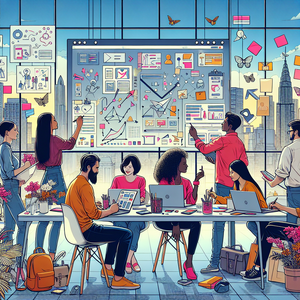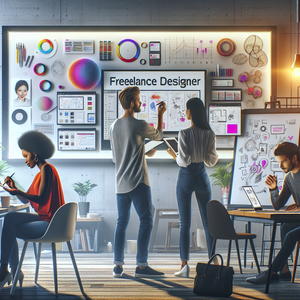Balancing Collaboration and Independence as a Remote UI/UX Designer

The onset of the COVID-19 pandemic acted as a catalyst for the shift to remote work, compelling organizations to adapt swiftly to new collaboration methods. In UI/UX design, where user-centric products rely heavily on teamwork, this transition has introduced both hurdles and innovative approaches. Remote work offers designers the flexibility to tap into a global talent pool and work from various locations. However, it also demands a significant adjustment in communication and collaboration practices. The need for effective tools and strategies to sustain creativity and productivity in this new landscape is more crucial than ever.
The Challenges of Remote Collaboration
One of the most pressing challenges for remote teams is managing time zone differences. When designers and developers are spread across various regions, real-time collaboration becomes increasingly difficult. A designer in New York may struggle to align schedules with a developer in London. This disparity can delay feedback and decision-making, stalling project progress. Thus, teams must establish clear communication protocols and set expectations for response times.
Isolation and Loneliness
Remote work can often lead to feelings of isolation, particularly for creatives who thrive on interaction and collaboration. The absence of spontaneous in-person brainstorming sessions can dampen creativity and motivation. A UI/UX designer who previously enjoyed lively discussions with colleagues may feel disconnected when confined to virtual meetings. This isolation can contribute to burnout and decreased job satisfaction, making it essential for teams to find ways to foster connection.
Maintaining a Design Culture
Creating a cohesive design culture in a remote setting can prove challenging. New team members may struggle to integrate into the company’s culture without the informal interactions that typically occur in an office environment. A newly hired designer might find it difficult to grasp the company’s design philosophy or processes without the benefit of in-person mentorship. This gap can hinder their ability to contribute effectively, emphasizing the need for structured onboarding processes.
Strategies for Balancing Collaboration and Independence
To successfully navigate these challenges, remote UI/UX designers can adopt several strategies.
Leverage Technology
Utilizing collaboration tools such as Figma, Miro, and Slack can significantly enhance real-time brainstorming, feedback, and project management. These platforms help bridge the gap created by physical distance. According to a study from the Harvard Business Review, teams that employed collaborative design tools reported higher levels of engagement and creativity, as they could share ideas and iterate designs in real-time.
Establish Clear Communication Channels
Creating structured communication protocols helps manage expectations and reduces stress related to feedback timelines. Regular check-ins and updates ensure that teams remain aligned and informed. Implementing a weekly stand-up meeting can establish a consistent rhythm for team updates, fostering accountability and ensuring that everyone is on the same page.
Foster Virtual Connections
Encouraging informal interactions among team members through virtual coffee breaks or team-building activities can create a sense of belonging and enhance relationships. Organizing a monthly virtual game night allows team members to bond in a relaxed environment, promoting camaraderie and collaboration outside of work-related tasks.
Set Boundaries for Independence
While collaboration is vital, designers must also carve out time for focused work. Establishing designated 'deep work' periods can help maintain productivity without constant interruptions. Research by Cal Newport, author of Deep Work, suggests that uninterrupted work time significantly boosts creativity and efficiency, which are essential for UI/UX design tasks.
Balancing collaboration and independence as a remote UI/UX designer presents both challenges and opportunities. By leveraging technology, establishing clear communication, fostering virtual connections, and setting boundaries for focused work, designers can effectively navigate the complexities of remote work. As the industry continues to evolve, embracing these strategies will not only enhance productivity but also cultivate a more connected and creative remote design community. In this new landscape, the ability to thrive in both collaborative and independent settings will define the future of UI/UX design, ensuring that designers can continue to create user-centered solutions that resonate globally.
Remote UI/UX Designer
InVision, Shopify, various tech startups
Core Responsibilities
Conduct user research and usability testing to gather insights that inform design decisions.
Create wireframes, prototypes, and high-fidelity designs using tools like Figma and Adobe XD.
Collaborate with cross-functional teams to ensure design consistency and alignment with user needs.
Required Skills
Proficiency in design software (e.g., Figma, Sketch, Adobe Creative Suite).
Strong understanding of user-centered design principles and methodologies.
Excellent communication skills for effective remote collaboration.
UI/UX Researcher
UserTesting, Google, design consultancies
Core Responsibilities
Plan and conduct qualitative and quantitative user research to inform product design.
Analyze user behavior and feedback to identify areas for improvement in user experience.
Present findings and recommendations to stakeholders to drive design decisions.
Required Skills
Familiarity with research methodologies (e.g., surveys, interviews, usability testing).
Strong analytical skills and experience with data visualization tools.
Ability to communicate research findings clearly and persuasively.
Product Designer specializing in Mobile Applications
Airbnb, Uber, various mobile app development agencies
Core Responsibilities
Design intuitive and engaging mobile user interfaces that enhance user experience on iOS and Android platforms.
Collaborate with developers to ensure design feasibility and implementation accuracy.
Iterate on designs based on user feedback and analytics to improve usability and engagement.
Required Skills
Proficiency in mobile design tools (e.g., Sketch, Figma) and understanding of mobile design guidelines.
Experience with prototyping and usability testing specifically for mobile applications.
Strong problem-solving skills and a keen eye for detail.
Interaction Designer
Microsoft, Adobe, various design agencies
Core Responsibilities
Develop interactive prototypes to demonstrate user flows and interactions.
Collaborate closely with UI designers and developers to create seamless user experiences.
Conduct A/B testing to evaluate interaction designs and optimize user engagement.
Required Skills
Strong understanding of interaction design principles and user interface aesthetics.
Proficiency in prototyping tools (e.g., Axure, InVision) and knowledge of HTML/CSS is a plus.
Ability to think critically about user interactions and provide innovative solutions.
UI/UX Design Lead
Amazon, Facebook, well-established design firms
Core Responsibilities
Lead and mentor a team of designers, fostering a collaborative and innovative design culture.
Oversee the design process from concept to execution, ensuring alignment with business goals and user needs.
Coordinate with product managers and developers to prioritize design initiatives and deliver quality outputs.
Required Skills
Extensive experience in UI/UX design with a strong portfolio showcasing leadership in design projects.
Excellent communication and interpersonal skills to effectively manage team dynamics and stakeholder relationships.
Strategic thinking and the ability to translate business goals into effective design solutions.


